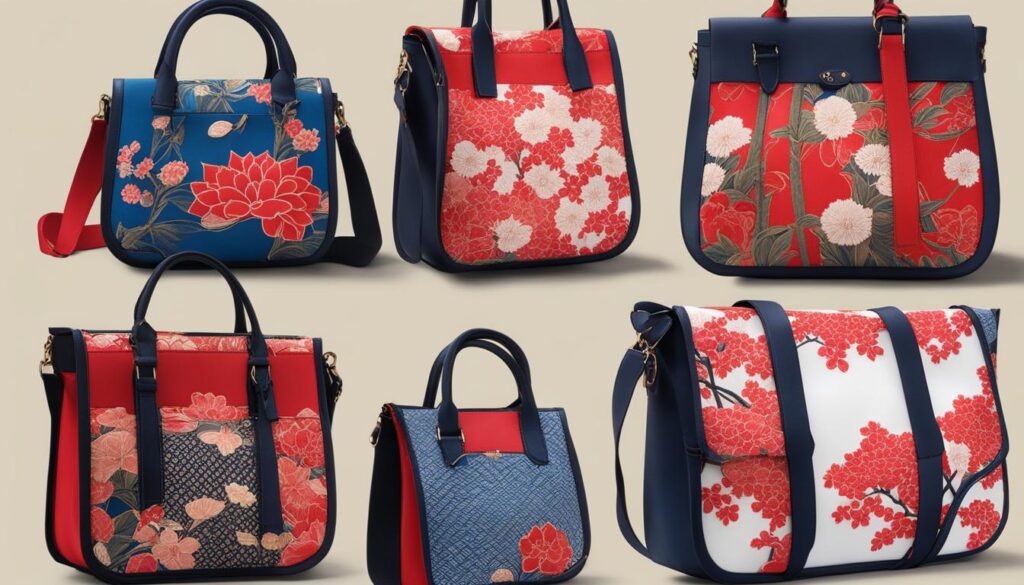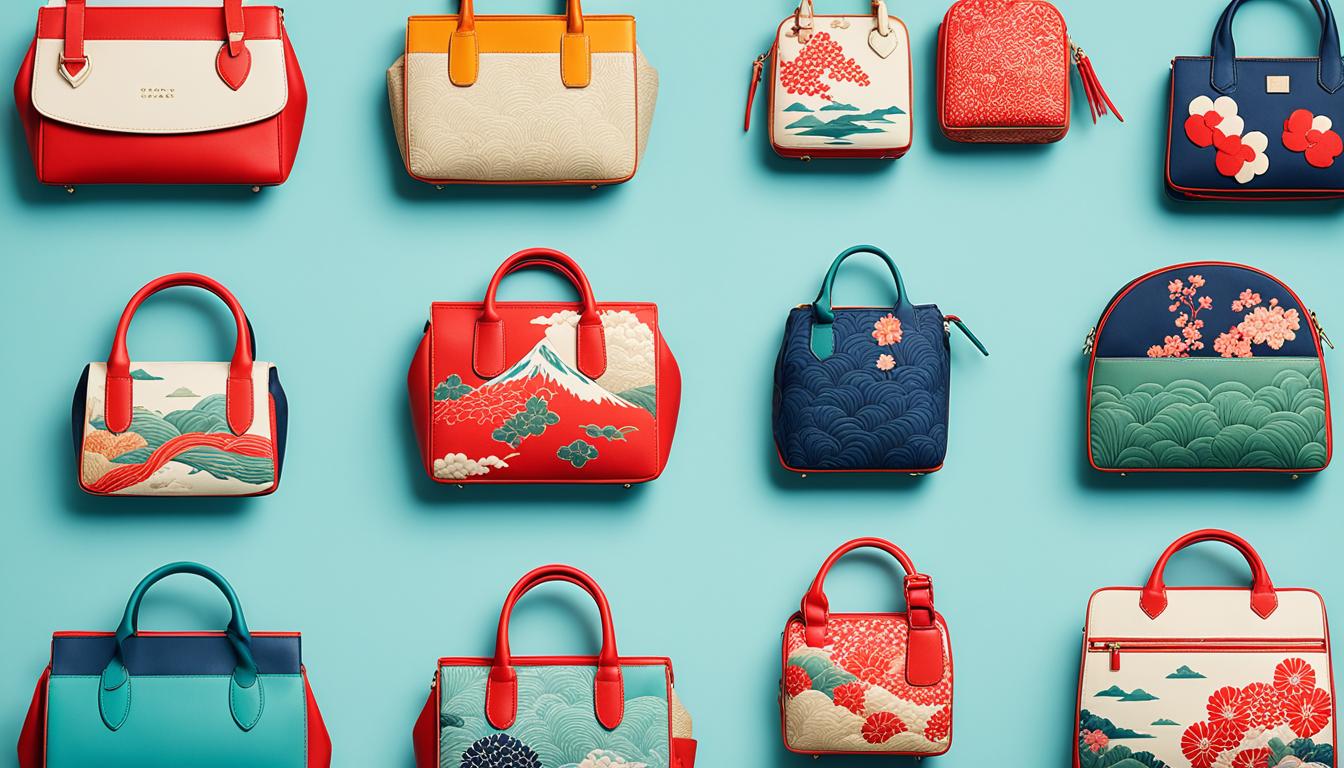Welcome to our exploration of bags in Japanese tradition and fashion. In this article, we will delve into the meaning, grammar, pronunciation, and cultural usage of various styles of bags in Japan. From traditional to modern, authentic to fashionable, Japanese bags encompass a rich heritage that continues to captivate people worldwide.
Whether you are interested in traditional Japanese bags, modern fashion trends, or the cultural significance behind these accessories, this article has you covered. Bags in Japanese tradition and fashion have gained global appeal for their unique styles, craftsmanship, and attention to detail. Join us on this journey as we delve into the world of bags in Japanese tradition and fashion.
Furoshiki: The Traditional Japanese Cloth for Wrapping and Carrying
Furoshiki is a traditional Japanese cloth that has been used for centuries for both wrapping and carrying items. It embodies the essence of Japanese culture, showcasing the principles of minimalism, simplicity, and elegance. Furoshiki is not only a practical way to transport belongings but also a beautiful and versatile accessory that reflects the Japanese value of balance and harmony with nature.
The beauty of furoshiki lies in its ability to be folded and tied in various ways, allowing it to transform into different bag-like structures. Whether it’s a handbag, tote bag, or even a backpack, furoshiki offers a range of possibilities for carrying your essentials. This versatility makes it a sustainable and environmentally friendly alternative to single-use plastic bags that harm the planet.
Each fold and knot used in furoshiki has a purpose and is often woven with cultural significance. The artistry and craftsmanship behind these intricate designs embody the traditional Japanese aesthetic. By using furoshiki, you not only experience the practicality of a well-designed bag, but you also become part of a centuries-old tradition that values functionality, elegance, and mindful consumption.
Today, furoshiki continues to be used in Japan for a variety of purposes, ranging from carrying groceries to wrapping gifts. Its popularity is not limited to Japan alone, as it has gained international recognition as a sustainable and stylish bag option. People around the world are embracing furoshiki for its unique combination of practicality, aesthetics, and eco-friendliness.
Take a moment to appreciate the beauty and functionality of furoshiki by incorporating it into your daily life. Join the movement of embracing authentic Japanese bags and make a sustainable choice while adding a touch of elegance to your style.
Jhola Bags: Vibrant Cultural Heritage of India
Jhola bags are an integral part of India’s cultural heritage. These colorful and intricately designed bags are associated with spiritual gatherings, rural life, and traditional festivals. They reflect the rich cultural diversity of India and serve as a symbol of its vibrant traditions. Jhola bags are made of various materials such as canvas and are often adorned with traditional embroidery and patterns. They are not only functional but also carry a sense of identity and pride among the Indian communities.
Whether used for carrying daily essentials or as accessories for special occasions, jhola bags showcase the artistry and craftsmanship of Indian artisans. The intricate embroidery and vibrant colors of these bags draw inspiration from the country’s diverse culture and traditions.
These traditional bags are not just fashion accessories, but they also have deep symbolic meaning. Jhola bags represent the connection to one’s roots, the celebration of cultural diversity, and the preservation of age-old traditions. The craftsmanship that goes into creating these bags reflects the skill and dedication passed down through generations.
Jhola bags are versatile and can be worn across different outfits and styles. They add a touch of cultural authenticity to any ensemble, making them popular not only in India but also with fashion enthusiasts around the world.
Whether you are looking for a unique accessory that tells a story or a functional bag that carries a piece of India’s heritage, jhola bags are a perfect choice. Their vibrant colors, intricate designs, and cultural significance make them truly authentic and special.
Modern Japanese Bags: Fashionable, Functional, and Unique
In addition to traditional bags, modern Japanese bags have gained popularity for their unique styles, functionality, and incorporation of contemporary fashion trends. Brands like FRNKOW have introduced innovative designs such as the Dumpling Bag, which combines style, functionality, and cultural inspiration.
These modern bags often feature bold shapes, vibrant colors, and materials that blend traditional craftsmanship with modern aesthetics. Japanese fashion bags are known for their impeccable attention to detail, quality craftsmanship, and ability to effortlessly complement various outfits and occasions. They have become sought-after accessories for fashion enthusiasts worldwide.

Whether it’s a structured handbag, a sleek tote, or a versatile crossbody, modern Japanese bags offer a wide range of options that cater to every individual’s style preferences and functional needs. These bags are not only fashion-forward but also showcase the cultural heritage and craftsmanship that Japan is renowned for.
From renowned luxury brands to emerging designers, the modern Japanese bag market offers a diverse selection that appeals to a global audience. These bags effortlessly fuse contemporary fashion trends with Japanese aesthetics, creating pieces that are both visually striking and functional.
For example, the Dumpling Bag by FRNKOW, with its unique shape inspired by Japanese cuisine, showcases the fusion of cultural inspiration and modern design sensibilities. Its bold colors and meticulous craftsmanship make it a standout accessory that adds a touch of sophistication to any outfit.
With their attention to detail, quality materials, and timeless appeal, modern Japanese bags have become coveted items that elevate any ensemble. Whether you’re attending a formal event or running errands, these bags effortlessly combine style and functionality, making them a must-have for any fashion-conscious individual.
Comparison Table: Modern Japanese Bag Brands
| Brand | Style | Key Features | Price Range |
|---|---|---|---|
| FRNKOW | Dumpling Bag | Innovative shape inspired by Japanese cuisine, bold colors | $100-$300 |
| Orient Edition | Kimono-inspired tote | Traditional Japanese textile patterns, spacious interior | $200-$500 |
| Sakura Blossom | Cherry blossom crossbody | Embroidered cherry blossom motifs, adjustable strap | $50-$150 |
| Kuroiwa | Minimalist bucket bag | Clean lines, premium leather, detachable shoulder strap | $300-$700 |
Note: Prices are approximate and may vary.
Cultural Significance of Bags in Japanese Tradition
Bags hold significant cultural symbolism in Japanese tradition. They are not just utilitarian items but also represent social status, personal values, and aesthetic sensibilities. In traditional Japanese society, bags were often associated with specific social roles and professions, such as the iconic samurai bag or the elegant pouches carried by geishas. Bags were also used in traditional ceremonies and rituals, symbolizing purity, prosperity, and protection. Today, the cultural significance of bags in Japanese tradition continues to influence modern designs and fashion trends.
| Bag Type | Social Symbolism |
|---|---|
| Samurai Bag | Represents bravery and honor |
| Geisha Pouch | Signifies femininity and grace |
| Traditional Ceremony Bags | Symbolize purity, prosperity, and protection |
Bags in Japanese Fashion: Bridging Traditional and Contemporary Styles
Japanese fashion seamlessly combines traditional and contemporary elements, and bags play a pivotal role in complementing and completing the overall look. Whether you prefer sleek and minimalist designs or bold and avant-garde creations, Japanese fashion bags embody the country’s rich cultural heritage while embracing modern aesthetics. Renowned for their attention to detail, exquisite craftsmanship, and innovative use of materials, Japanese designers have created a diverse range of bags that are both functional and stylish.
When it comes to bags in Japanese fashion, they are not simply accessories but statement pieces that express individuality and personal style. Each bag tells a story, weaving together the threads of tradition and modernity. From ancient motifs and patterns to contemporary interpretations, these bags serve as a visual representation of Japan’s vibrant cultural identity.
Whether your style leans towards classic elegance or cutting-edge trends, there is a Japanese fashion bag that suits your taste. Let’s explore some popular types of bags that exemplify the seamless fusion of tradition and modernity:
| Bag Type | Description |
|---|---|
| Kimono Clutch | These small, handheld clutches are inspired by the traditional kimono and often feature intricate embroidery, vibrant colors, and delicate patterns. |
| Bento Bag | With its unique origami-inspired shape, the bento bag is a modern take on the traditional lunchbox. It is both stylish and functional, perfect for carrying daily essentials. |
| Furoshiki Tote | The furoshiki tote is a contemporary interpretation of the traditional furoshiki cloth. It can be folded and tied in different ways, offering versatility and eco-friendliness. |
| Obi Belt Bag | Transforming the obi belt into a fashionable bag, this accessory adds a touch of elegance and uniqueness to any outfit. |
Japanese fashion bags are not only visually appealing but also highly functional. Designers pay meticulous attention to the needs of modern individuals, ensuring that each bag offers practical features without compromising on style. Functionality blends seamlessly with aesthetics in Japanese fashion, creating bags that are both useful and visually captivating.
Whether you are looking for a statement piece to elevate your outfit or a functional bag that reflects your appreciation for Japanese culture, bags in Japanese fashion offer a wide range of options. Embrace the blend of tradition and modernity, and let your bag become a reflection of your personal style.
The Global Appeal of Bags in Japanese Tradition and Fashion
Bags in Japanese tradition and fashion have captivated a global audience with their unique styles, cultural significance, and commitment to quality and craftsmanship. These bags not only serve as functional accessories but also embody a timeless elegance that continues to inspire designers and fashion enthusiasts around the world.
In traditional Japanese bags, such as Furoshiki and Jhola bags, the meticulous attention to detail and exquisite craftsmanship are unparalleled. Furoshiki, a traditional cloth used for wrapping and carrying items, showcases the Japanese philosophy of minimalism and simplicity, while Jhola bags from India exemplify vibrant cultural heritage. These traditional bags celebrate the rich traditions of Japan and India and have become symbols of cultural pride.
Modern Japanese bags seamlessly fuse traditional elements with contemporary designs, offering a fresh and unique perspective in the global fashion landscape. With their bold shapes, vibrant colors, and innovative materials, these bags have become sought-after accessories. From renowned brands like FRNKOW to emerging designers, modern Japanese bags consistently showcase the interplay between tradition and modernity.
Bags in Japanese tradition and fashion go beyond mere products. They represent a celebration of culture, craftsmanship, and personal style, uniting people from different backgrounds with a shared appreciation for beauty and heritage. Their global appeal stems from their ability to transcend borders and captivate individuals who seek authenticity and uniqueness in fashion. As these bags continue to inspire, they reinforce the enduring influence of Japanese tradition and fashion on the global stage.

